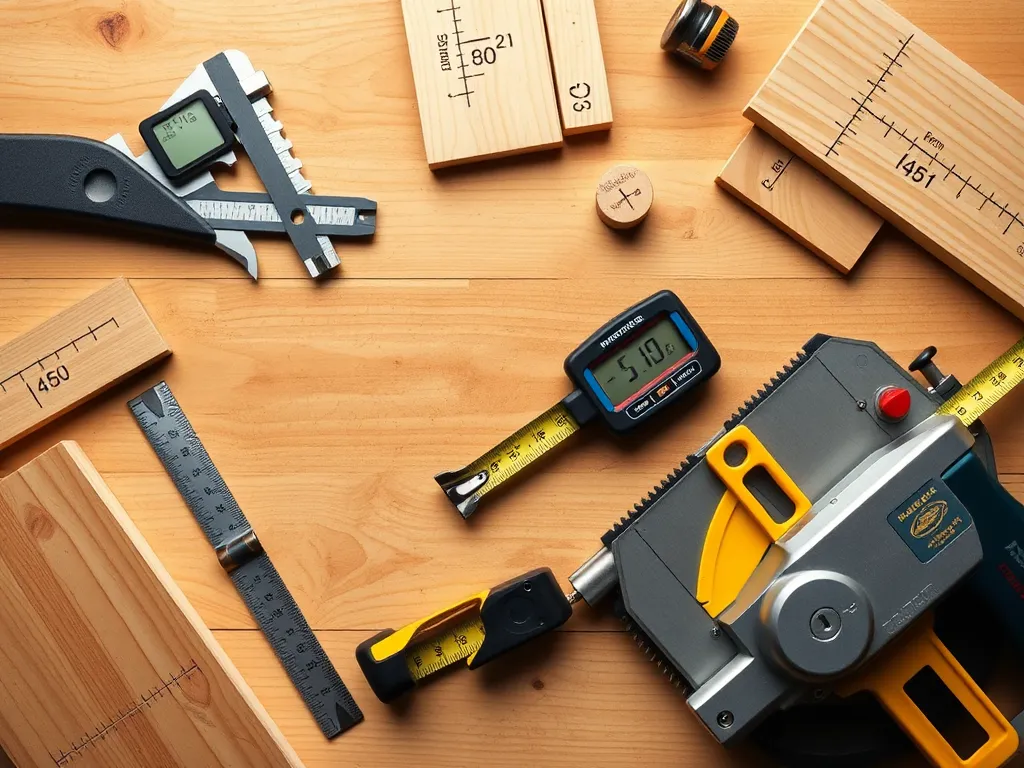Accurate Cutting Height: Essential Tools and Techniques

Tools and Techniques for Measuring Cutting Height Accurately
Accurate measurement of cutting height is crucial in various industries, including woodworking, landscaping, construction, and automotive engineering. When working on projects that require precision, the right tools and techniques for measuring cutting height accurately can make a significant difference in the final outcome. In this article, we will examine the various tools available for measuring cutting heights, useful techniques to achieve precise measurements, common mistakes to avoid, and the applications of accurate cutting height measurement.
Using appropriate lawn height tools ensures your grass remains healthy while promoting robust growth.
The measurement of cutting height is influenced by both the tools used and the techniques employed to utilize those tools. Various measuring tools are designed specifically for obtaining precise dimensions. Understanding the strengths and limitations of these tools will aid in achieving maximum accuracy. This guide provides insights into tools and techniques for measuring cutting height accurately and effectively addresses common pitfalls that can lead to inaccurate measurements.
Optimizing your cutting height measurements involves more than just using the right tools. It requires rigorous adherence to best practices and awareness of prevalent measurement mistakes. By embracing recommended techniques and consistently applying them, you enhance the quality of your work and avoid costly errors. Keep reading to discover helpful tips and engage with the different tools dedicated to measuring cutting height accurately.
In a world where precision is paramount, ensuring the right cutting height cannot be underestimated. By learning how to effectively utilize measuring tools, adopting correct measurement techniques, and acknowledging the potential missteps, both professionals and hobbyists alike can significantly enhance the quality of their work. In this article, we will explore not only tools and techniques but also practical applications and long-term care for your measuring instruments.
Therefore, investing in the right tools and mastering the techniques for measuring cutting height accurately can help produce superior results, streamline your workflow, and elevate the overall quality of your projects. Let’s delve into the primary categories of measuring tools and effective techniques that will enhance your cutting height measurements.
Types of Measuring Tools
**Tape Measures: Benefits and Uses** Tape measures are one of the most commonly used tools for measuring cutting height. They are flexible, portable, and can be easily stored. Tape measures are marked with both imperial and metric measurements, making them versatile for various projects. Their retractable nature allows for quick and straightforward measurement of cutting height, especially in DIY tasks or when dimensions need to be assessed on-site.
For optimal lawn care, understanding proper mower blade measurement can significantly enhance your mowing efficiency.
**Calipers: Precision Measurement Techniques** Calipers are used for more precise measurements, whether internal, external, or depth. They can provide accuracy to within a few tenths of a millimeter. Calipers come in various forms, including vernier, dial, and digital, catering to different precision needs. They are particularly useful in settings where fine adjustments are crucial, such as in automotive engineering or intricate woodworking projects.
Mastering grass ruler usage can lead to a well-maintained lawn and improve your mowing habits.
**Laser Levels: Enhancing Cutting Height Accuracy** Laser levels emit a highly precise beam of light to create straight lines for measurement. Utilizing laser technology, these tools provide an incredibly accurate reference point, eliminating many of the variabilities associated with manual measurement. Laser levels are ideal for larger projects where straightforward cutting height adjustments need to be achieved through visual cues.
**Digital Height Gauges: Advanced Features and Uses** Digital height gauges are designed for users who require high levels of precision. They feature a digital readout that makes reading measurements effortless and clear, minimizing the risk of misinterpretation. Some models have additional functionalities such as memory for storing measurements and connectivity options for integration with other tools, making them invaluable in workshops and industrial settings.
Techniques for Accurate Measurement
**Best Practices for Using Measuring Tools** To achieve the most accurate cutting height measurements, initiating a routine that focuses on best practices is essential. This includes ensuring that the measuring tool is undamaged, using stable surfaces for supporting the item being measured, and always taking measurements from the same reference point to maintain consistency.
**Proper Calibration Methods for True Measurement** Calibration is crucial for maintaining the accuracy of measuring tools. Regularly checking the precision of tools against known standards helps identify deviations. Many tools, especially digital ones, allow users to recalibrate easily, ensuring their readings remain reliable and true to actual dimensions.
**Techniques for Compensating for Surface Irregularities** Surface irregularities—such as grooves, bends, or dirt—can severely impact measurement accuracy. Using flat reference blocks or data collection methods can help offset surface imperfections. Additionally, recording multiple measurements and calculating an average can improve reliability in imperfect conditions.
**Strategies for Measuring in Hard-to-Reach Areas** Some cutting height measurements require access to tight or awkward spaces. Flexible measuring tapes, inspection mirrors, or specialized tools with extendable arms can make these measurements easier and more accurate. Always aim for stability and a consistent measuring angle to mitigate risks of misreading.
Common Mistakes in Measuring Cutting Height
**Overcoming Parallax Errors in Measurement** A common mistake in measurement arises from parallax error, which occurs when the observer's eye is not aligned directly with the measurement scale. To avoid this, always ensure your line of sight is perpendicular to the measurement scale when reading values to enhance precision.
**Importance of Surface Preparation for Accurate Cuts** Before measuring, it's imperative to prepare the surface properly. Cleaning the area of dust or debris and ensuring it's level can vastly improve the accuracy of the cutting height measurements. Neglecting this step can result in significant discrepancies in the eventual cuts made.
**Misreading Measurements: How to Avoid It** Misreading can occur due to fatigue, distraction, or misinterpretation of scales. Implementing a system where someone double-checks measurements can significantly curb this issue. Furthermore, using digital tools with clear displays can minimize the chances of human error.
**Using Inconsistent Measurements: Pitfalls and Solutions** Consistency is key in measurement. Using different units or tools across the same project can lead to confusion and mistakes. To avoid this, standardize your measuring tools (use either metric or imperial consistently) and create a measurement log for reference.
Applications of Accurate Cutting Height Measurement
**Importance in Cabinet Making and Furniture Design** Accurate cutting height measurements are foundational in furniture design and cabinet making. Precision ensures that joints fit seamlessly, leading to higher quality and aesthetically pleasing outcomes. The reliability of measurements translates to functional and durable products.
**Impact on Landscaping and Gardening** In landscaping, cutting heights influence plant health and aesthetic appearances. Measuring cutting heights with accuracy can ensure that blades and machinery maintain proper heights for grass and shrub maintenance, leading to healthy, well-manicured environments.
**Role in Construction and Renovation Projects** In construction and renovation, accurate cutting height measurements affect material fitting and structural integrity. Builders must ensure materials fit together correctly for safety, longevity, and minimizing waste during the project.
**Benefits in Automotive and Mechanical Engineering** In automotive engineering, precise cutting height can directly impact performance and efficiency. Components must be consistently measured to ensure proper assembly and functionality, thereby promoting safety and enhancing vehicle performance.
Maintenance and Care of Measuring Tools
**Cleaning Techniques for Longevity of Tools** Regular cleaning of measuring tools is critical to their longevity and accuracy. Using a soft cloth and appropriate cleaning solutions can help remove oils, dust, and debris that may affect measurement precision. Always ensure tools are thoroughly dried before storing them.
**Calibration Routines for Optimal Accuracy** Establishing a calibration routine is fundamental to ensure your measuring tools remain accurate. Set up a regular schedule based on usage frequency to check and recalibrate items like digital height gauges and calipers.
**Storage Solutions to Prevent Damage** Proper storage of measuring tools protects them from damage. Employing tool boxes or tool cabinets with padded compartments helps safeguard delicate components while preventing scratches or warping.
**Addressing Common Wear and Tear Issues** Regular inspections for wear and tear can preemptively address accuracy problems in measuring tools. Assessing and replacing worn components and ensuring moving parts are functional contributes to the overall accuracy and reliability of the tools.
